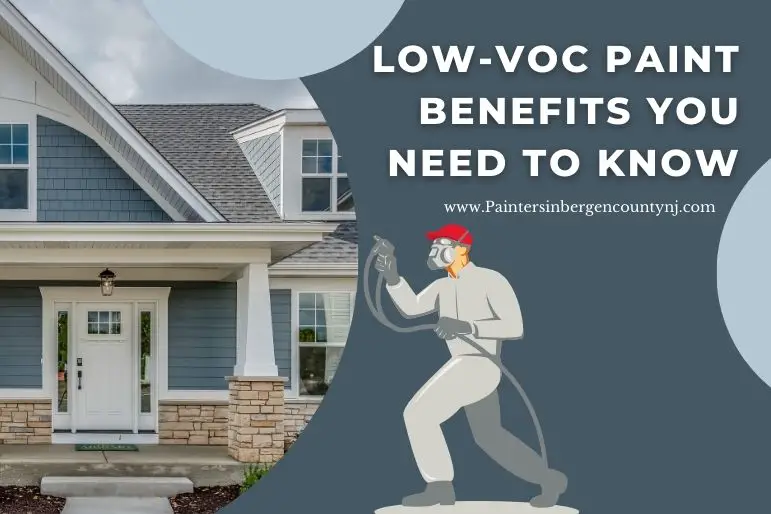Painting your home is an exciting way to transform your living space. Choosing the right type of paint is important for any painting project, whether you’re just covering up a few spots or re-painting your whole house. With so many different types of paint to choose from, it can be difficult to know which one to choose. But, studying and evaluating the advantages of each kind of paint is worth the effort.
When selecting paint for your project, considering the quantity of volatile organic compounds (VOCs) it contains is crucial. Low VOC paint has become more popular because it offers many benefits. This article will explain the benefits of using low-VOC paint for your next project.
What are Low VOC Paints?
Before we delve into the benefits of low-VOC paint, let’s define what it is. VOCs are chemicals that vaporize at room temperature and can be found in traditional paints. When the paint dries, the VOCs in it evaporate and release fumes, which can cause negative health effects. Continued inhalation of the fumes could cause lasting health problems, such as ongoing headaches and dizziness. Their well-being relies on having this knowledge, so it’s crucial. To ensure safety, it is advisable to use low-VOC paints that have a lower concentration of volatile organic compounds. Zero VOC paint is a type of low VOC paint with little or no volatile organic compounds, making them the safest type of paint to use.
Benefits of Low VOC Paint
Better Air Quality:
Low VOC paint emits fewer harmful chemicals into the air, resulting in better air quality. Individuals with pre-existing respiratory conditions, like asthma, should be aware that VOCs present in regular paints can have greater negative effects on them. Their well-being depends on possessing this knowledge.
Healthier Environment:
Low VOC paints are environmentally friendly products that are better for your health and the environment. Traditional paints release harmful chemicals, contributing to air pollution and other environmental problems. Low VOC paint reduces the negative impact of painting on the environment, making it a more sustainable choice.
Safer for Human Health:
As mentioned earlier, VOCs in traditional paints can have a negative impact on human health. Low VOC paint significantly reduces the risk of respiratory issues and other health problems. Using low-VOC paint can help ensure that your home is a safe and healthy environment.
Cost-Effective:
While low VOC paints may initially cost more than regular paints, they are cost-effective in the long run. Because low VOC paint has a longer lifespan than regular paint, you won’t need to repaint it as frequently. These are perfect for areas with a lot of foot traffic, like hallways and kids’ bedrooms.
Durable Coatings:
Another advantage of low-VOC paints is their durability. Low VOC paint has strong coatings that resist stains, dirt, and general wear and tear. These items are perfect for areas that have a lot of people walking through them, like hallways and rooms for kids.
Reduced Odor:
Low VOC paint emits fewer fumes and has less of a smell than traditional paints, making it ideal for those with sensitivity to strong odors. This makes it easier to live in your home immediately after painting without having to worry about the strong smell that can linger for days.
More Environmentally Friendly Products:
Using low VOC paint is a step towards creating a more environmentally friendly home. Traditional paints contribute to air pollution and other environmental problems, whereas low-VOC paints are much safer and have a significantly lower impact on the environment.
How to Choose Low VOC Paint
When choosing low-VOC paint, it’s essential to look for products that are labeled as low or zero VOC and have a VOC content of fewer than 50 grams per liter. When choosing paint for your project, don’t forget to think about the color and type. Some colors and finishes might contain more VOCs than others, so make sure to research and pick the right choice based on your requirements.
It’s also important to take precautions during a painting project to protect your health and the environment. Here are some tips:
Use Protective Gear:
Wear a respirator mask, gloves, and goggles when painting to protect yourself from toxic fumes and chemicals.
Open Windows:
Open windows and use fans to improve ventilation during the painting process. Reducing the concentration of harmful chemicals in the air can be achieved with this.
Choose the Right Time:
Avoid painting during high humidity or extreme temperatures, as this can affect the quality of the paint and increase the level of VOCs in the air.
Clean up with Non-Toxic Products:
To ensure safety, please clean up after the painting project using cleaning products and air fresheners that are non-toxic. Traditional cleaning products and air fresheners can contain harmful chemicals that can negate the benefits of using low-VOC paint.
High VOCs and the Paint Industry
The paint industry has traditionally relied on high-VOC paints because they are cheaper and easier to produce. While some paint companies now provide low-VOC paint choices, there are still manufacturers who make high-VOC paints that can have negative impacts on human health and the environment. It is important to be informed about the potential risks when choosing paint products in order to make safe decisions. It’s important to choose paints with low VOCs whenever possible to reduce the negative impact of painting on the environment and human health.
Conclusion
To summarize, choosing low-VOC paint is a great way to enhance the air quality indoors, promote healthier surroundings, and minimize the detrimental effects that painting has on the environment. Low VOC paints emit fewer harmful chemicals, have durable coatings, and reduce the risk of respiratory issues, among other benefits.
While low VOC paints may initially cost more than regular paints, they are cost-effective in the long run. Low VOC paint has a longer lifespan than regular paint, reducing the need for frequent repainting.
By choosing low-VOC paint, you can create a safer, healthier, and more environmentally friendly home.
References
https://blog.chesterton.com/wear-protection/low-volatile-organic-compound-voc-coatings
https://www.thespruce.com/low-voc-paint-and-no-voc-paint-1976533
https://enviroklenz.com/advantages-of-using-paints-with-low-vocs-2/

